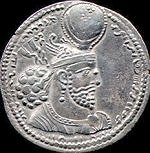Bahram II
Bahram II was the fifth Sassanid King of Persia in 276–293.
He was the son of Bahram I (273–276).
Bahram II is said to have ruled at first tyrannically, and to have greatly disgusted all his principal nobles, who went so far as to form a conspiracy against him, and intended to put him to death. The chief of the Magi, however, interposed, and, having effectually alarmed the king, brought him to acknowledge his wrong and to promise an entire change of conduct. The nobles upon this returned to their allegiance; and Bahram, during the remainder of his reign, is said to have been distinguished for wisdom and moderation, and to have rendered himself popular with every class of his subjects.
He is believed to have been involved in a campaign in Sakasthan (the modern-day Sistan) and Afghanistan. The hostilities ended in 283 with Bahram's victory in Sakasthan.
Hostilities with Rome
In 282, Roman Emperor Carus crossed the Euphrates along with his troops and invaded Mesopotamia wreaking havoc. Bahram II was not able to offer any resistance as his troops were occupied with the campaign in Afghanistan. Mesopotamia was ravaged and the cities of Selucia and Ctesiphon were occupied by the Roman troops. However, as an oracle had predicted earlier, the death of Carus cut short his career as well as the Roman advance.
The circumstances of Carus's death remain mysterious and inexplicable to this very day. As he was in his camp near Ctesiphon, recuperating from an illness that had struck him, there was a thunderstorm. A weird darkness had overcome the camp and was accompanied by flashes of lightning. Then, suddenly, there was a loud clap and the cry went that the Emperor was dead. Some said that his tent had been struck by lightning, and that his death was owing to this cause; others believed that he had succumbed to his illness at the exact moment of the thunder-clap; a third theory was that his attendants had taken advantage of the general confusion to assassinate him, and that he merely added another to the long list of Roman emperors murdered by those who hoped to profit by their removal.
Following Carus's death, the Romans retreated and Carus's son, Numerian, concluded peace with the Persians.
In A.D. 286, however, the celebrated Diocletian resumed hostilities with Persia, and marched into Persian territory in aid of the Armenian prince Tiridates who was in rebellion against Persia. Armenia was liberated after a couple of battles and Tiridates declared himself independent.
Tiridates achieved extraordinary success during this period. He defeated two Persian armies in the open field, drove out the garrisons which held the more important of the fortified towns, and became undisputed master of Armenia. He even crossed the border which separated Armenia from Persia, and gained signal victories on admitted Persian ground.
Bahram II died soon afterwards in an extremely dejected state.
Of Bahram II's reign some theological inscriptions exist (F. Stolze and J.C. Andreas, Persepolis (1882), and E.W. West, "Pahlavi Literature" in Grundriss d. iranischen Philologie, ii. pp. 75–129).
| Sassanid dynasty | ||
|---|---|---|
| Preceded by: Bahram I |
Great King (Shah) of Persia 276 –293 |
Succeeded by: Bahram III |
ReferencesISBN links support NWE through referral fees
- 'The Civilizations of the Ancient Near East Volume 7' by George Rawlinson
- William Leadbetter, "Carus (282-283 C.E.)", "DIR"
ca:Bahram II cs:Bahrám II. de:Bahram II. es:Bahram II eu:Bahram II.a fa:بهرام دوم fr:Vahram II hr:Bahram II. it:Bahram II ja:バハラーム2世 no:Bahram II av Persia pl:Bahram II ru:Варахран II sk:Báhrám II. sv:Bahram II tr:II. Behram zh:巴赫拉姆二世
Credits
New World Encyclopedia writers and editors rewrote and completed the Wikipedia article in accordance with New World Encyclopedia standards. This article abides by terms of the Creative Commons CC-by-sa 3.0 License (CC-by-sa), which may be used and disseminated with proper attribution. Credit is due under the terms of this license that can reference both the New World Encyclopedia contributors and the selfless volunteer contributors of the Wikimedia Foundation. To cite this article click here for a list of acceptable citing formats.The history of earlier contributions by wikipedians is accessible to researchers here:
The history of this article since it was imported to New World Encyclopedia:
Note: Some restrictions may apply to use of individual images which are separately licensed.

